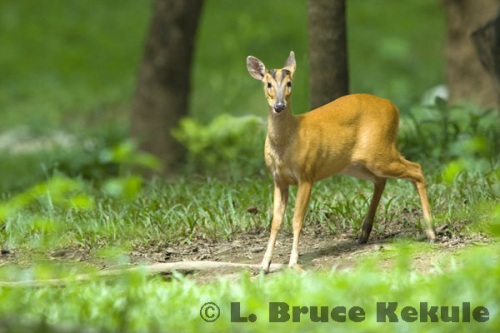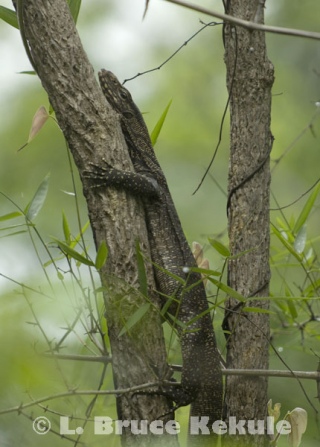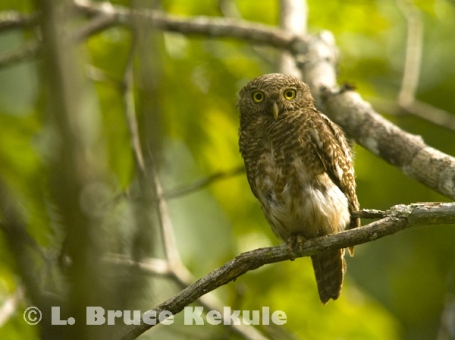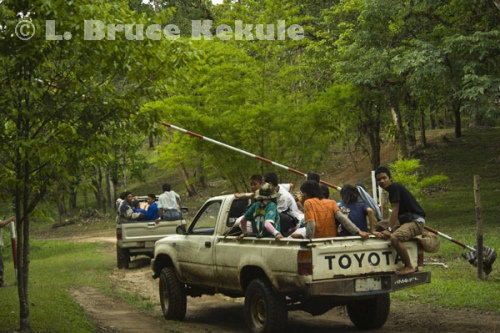Jewel in The Kingdom – Part Two
Thung Yai Naresuan Wildlife Sanctuary:
Thailand’s largest protected area and World Heritage Site
A look at present-day Thung Yai
When construction of hydroelectric dams was in vogue back in the early 1980s, the Mae Nam Choan dam project was put on the drawing board. If completed, it would have devastated about a thousand square kilometers of absolutely pristine habitat in Thung Yai including parts of the grassland. Many beautiful creatures would have perished or been pushed into the steep terrain by the rising floodwaters.
Mae Nam Choan
Logistics was a nightmare due to the rough terrain where the dam site was planned but the designers persisted. The Electrical Generating Authority Thailand (EGAT) cut a road through virgin forest in the sanctuary to the Mae Nam Choan River and a large supply camp was built.
Female muntjac in Song Tai ranger station
Conservationists organized a protest against construction of the dam. Grassroots people, NGOs, movie stars, pop stars and religious groups all joined the fracas and stayed until 1988, when the project was officially scrapped. This long-lasting protest was the first big success for wildlife conservationists in Thailand, and an instance in which the government was forced to yield to public opinion. The river still runs wild today. A legacy of preserving the natural world was set in place. Further outcries against mega-schemes in other parts of the country were brought to the forefront.
Large Indian civet at night in Song Tai
Nonetheless, the threat of large-scale destruction of natural habitat through the building of dams remains today, both within Thailand, and on key rivers in adjacent countries. Power producers, irrigation officials and others with political influence, want to build dams, sometimes just for the money. But with other alternate sources of power, building a dam purely to generate electricity is not credible.
China, Burma, Laos, Vietnam and Cambodia all have dam projects on the drawing board, recently completed or are under construction. The future of many rivers and wilderness areas in Southeast Asia is grim as modernization continues to wreck havoc on the natural world.
Forest monitor on a tree close to the Choan River
In 1996, I began visiting this wonderful place photographing its wildlife and forest. On my first trip into the interior, I miscalculated the distance to the headquarters at Song Tai and almost run out of fuel for my old ‘Series 1 Land Rover’. The chief at the time, Manop Chumpoochun gladly helped with enough gas to get back out to the nearest pump. Manop (now retired from the government) and I have been friend’s ever-since and we get together from time to time. He was a big help in finding wildlife subjects to photograph.
In those days, the road was tough especially after a rain but was still negotiable in most places. However, off-road groups from Bangkok would sometimes enter in large groups of 25 or more vehicles tearing up the road in certain areas making deep ruts where water naturally seeps from the ground creating havoc. Detour roads were then cut where possible further destroying the forest and making the road extremely rough on standard 4X4 trucks used by the rangers.
Siamese cat snake after eating a bird from a nest
Years later, the department set-up a new rule allowing only three off-road trucks at a time, which was suppose to cut down on the amount of vehicles that entered. However, the trick then used by these off-road groups was to mass outside the sanctuary and enter in groups of three gathering in the forest later where big parties were held. Racing at breakneck speed and testing their automobiles, tires and suspension systems was the program without any thought for the rangers or the forest and wildlife.
Due to political pressure and leverage, it seems some of these off-road groups continue to enter Thung Yai when permission is granted. Evidence of their passage is found every few kilometres or so. It is without doubt – Thung Yai is the toughest challenge for these thrill seekers in Thailand. It certainly needs attention and a proper mandate set-up by the DNP. These off-road groups should be scrutinized before allowing entry to minimize further destruction.
Asian barred owlet in the morning at Song Tai
Due to the state of the road, patrolling has always been kept to a minimum. It is also very difficult with just a few vehicles, a small staff, and a restricted budget that continues to cripple the protected area. Both Thung Yai west and east have similar problems relating to encroachment and poaching.
Another damaging aspect is the amount of regular traffic on the road through the middle of the sanctuary to the Karen village of Jagae. There is almost daily travel to and from the village, either people walking through or as motorized transport, especially during the dry season. Also, Buddhist monks enter for spiritual reasons or are in transit, possibly in the hundreds during the dry season. A taxi service of off-road vehicles runs from the mining town of Klity to Jagae and back, and the flow of people are basically unrestricted.
Taxi service in Thung Yai – Excessive traffic through the sanctuary
and a drain on the environment
Recent settlements are either Hmong or Karen, and there are about 15 villages situated within the boundaries of the protected area. The villagers claim they have been here for more than 150 years. The big question is: where will these people expand? They seem most likely to take over more fertile areas, displacing the wildlife, and turning it into agricultural farmland, or for grazing livestock.
In 1996 the village of Jagae had about a 100 households compared to just a dozen when the sanctuary was gazetted in 1974. Now there are more than 300 homes plus a school with possibly a thousand children. A large contingent of Border Patrol Police exists here too. It would be near impossible to move the mine and or the village, which has become completely entrenched.
My Ford Ranger entering a deep hole
To protect the grassland interior, a substitute route should be built from Jagae, going west into the town of Sangklaburi. Several bridges would need to be constructed to make the road suitable for all-weather use. So far, that remains just an idea. Hopefully some day, the government will address this problem and do something about these concerns to help preserve Thung Yai for the future.
As it stands, more and more people will continue to use the road, year in, year out, polluting it with trash. Poaching and forest gathering still remains a serious problem. Several years ago, a research team found two headless gaur carcasses side by side at an important mineral lick, indicating the beasts were killed with a large caliber rifle. Only the trophy and some meat were taken. All the protected areas in the ‘Western Forest Complex’ is plagued by the same problems related to gathering, poaching and encroachment.
Thung Yai’s tough road and my poor truck
It is vitally important to preserve Thung Yai Naresuan and Huai Kha Khaeng plus Umphang wildlife sanctuaries as one continuous conservation area – to maintain the integrity of habitats, the diversity of the flora and fauna, and complexity of all their ecosystems. Not enough is being done to restrain the relentless tide of humanity. Quick and decisive action is the only recourse, before it is too late.










